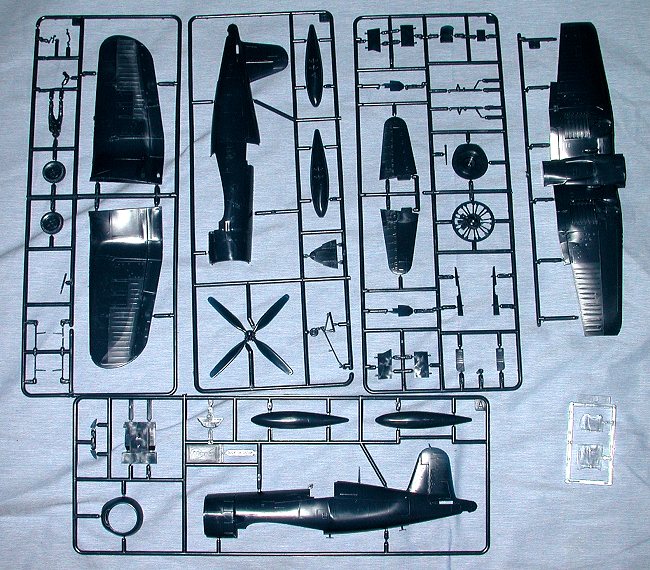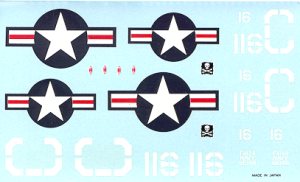
|
KIT: |
Hasegawa 1/48 F4U-4 Corsair |
|
KIT # |
U 3 |
|
PRICE: |
Currently, $18.98 |
|
DECALS: |
One aircraft |
|
REVIEW & |
|
|
NOTES: |
Ex-Mania kit |

|
HISTORY |
The F4U-4 is the ultimate WWII variant of the Corsair. The -4 introduced a more powerful engine, this time driving a four-bladed prop. It still had many of the same basic airframe parts as the earlier versions, but several of those were beefed up so that the Corsair could handle more ordnance. By the time the -4 entered service during the last year of the war, it was pretty obvious that the days of the specialized naval bomber were numbered. The Corsair was able to carry a heavier payload than the SB2C Helldiver and it did not need the extra crewman. Additionally, it was much faster and if it had to defend itself, it was more than a match for most of the adversaries it had to meet. The Marines loved the bird. It could carry a wide variety of ordnance, was fast, was rugged, and able to operate with ease from either rough strips or aircraft carriers.
Despite the wholesale canceling of contracts that occurred at the end of World War II, the Corsair was one of the few still kept in production, albeit at a much reduced rate. The final -4 rolled off the assembly line in mid 1947, only to be supplanted by even more updated versions. When the Korean War broke out in mid-1950, there were still plenty of F4U-4s in fleet service. They continued to be used with much success in the ground attack mission until the end of the war. Jets may be faster, but the Corsair could carry a respectable load and hang around to suppress enemy troops.
After seeing military service, a number of Corsairs joined the Air Racing circuit and decades later became the prize possessions of a few lucky warbird operators. The last military use of the Corsair was during the 'Soccer War' of 1969 between Honduras and El Salvador. Both countries operated the Corsair against each other, with those of Honduras being credited with a few air to air victories.
|
THE KIT |

This is one of several Mania designed kits that were put into Hasegawa's lineup after that company went out of business. In addition to several 1/72 kits, the Ki-27 and the older N1K2-J kits in 1/48 are ex-Mania models. Despite their now nearly 30 year old molds, these kits hold up extremely well against their more modern counterparts. Detailing is very good, even though it is of the raised panel line variety.
I have only seen this kit molded in blue and though I wish it were in medium or light grey, it still builds into a great model. The cockpit includes a tub with raised detail on the side consoles and instrument panel. It includes a seat and stick with a n additional seat cushion; rudder pedals of sorts are molded into the floor. The engine detail is good for its day consisting of the front bank of cylinders on a backing plate. The pushrods are molded on the front crankcase housing.
Landing gear detailing is quite good, though again, not up to modern standards. The wheel wells are a bit shallow for the main gear and non-existent for the tail wheel. There is a pilot figure. Kit includes a two-piece canopy that can be displayed open if you desire. Ordinance is limited to two drop tanks. Any bombs will have to come from the spares box. There is no provision for rockets at all, not even holes in the wings for stub launchers.
As befits a kit of this age, there are ejector pin marks on the inside of all the gear door and on the main landing gear. There are also a number on the cockpit floor which will be interesting to try to remove. However the rest of the kit is devoid of flash and the mold seams are quite small.
 Instructions are in both Japanese and English. There are colors
given where appropriate, but they are in generic colors and not keyed to any
brand of paint. Due to their age, my decals are starting to yellow a bit. They
are for one aircraft, an overall Gloss Sea Blue aircraft from VF-61 aboard the
USS Midway circa 1949. The decals are well printed, though a touch off register
with the red. Most of us will be using aftermarket decals to allow a more
interesting color scheme.
Instructions are in both Japanese and English. There are colors
given where appropriate, but they are in generic colors and not keyed to any
brand of paint. Due to their age, my decals are starting to yellow a bit. They
are for one aircraft, an overall Gloss Sea Blue aircraft from VF-61 aboard the
USS Midway circa 1949. The decals are well printed, though a touch off register
with the red. Most of us will be using aftermarket decals to allow a more
interesting color scheme.
Editors Note: Andrew Desautels recently wrote to me and logically explained that the markings for this aircraft could not have been when they were VF-61 as they did not deploy with the Corsair using that designation. However, they did deploy as VF-5B with the -4 though it was earlier and on board the Valley Forge, Coral Sea, and the FDR. By the time the Midway deployment was made, they had been redesignated VF-61 and converted to F8F Bearcats.
Andrew's research indicates that the
markings are from the late1947 Valley Forge deployment. On later
deployments, the squadron painted the tip of the tail white. If you want
to see a photo of this aircraft, it is in the Squadron-Signal USN Aircraft
Carrier Air Units Volume 1: 1946-56.
I can tell you that this kit builds very nicely and can be done quickly. It is still the best F4U-4 in 1/48 and is one that modelers of just about any skill level can do and have a very nice result.
Review kit courtesy of me and my wallet!
If you would like your product reviewed fairly and quickly by a site that has over 1,500 visits a day, please contact me or see other details in the Note to Contributors.